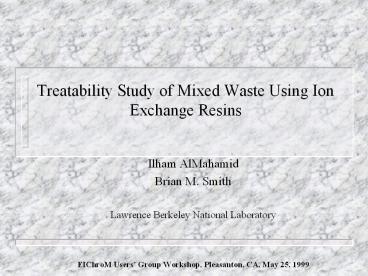Treatability Study of Mixed Waste Using Ion Exchange Resins PowerPoint PPT Presentation
1 / 19
Title: Treatability Study of Mixed Waste Using Ion Exchange Resins
1
Treatability Study of Mixed Waste Using Ion
Exchange Resins
- Ilham AlMahamid
- Brian M. Smith
- Lawrence Berkeley National Laboratory
- EIChroM Users Group Workshop, Pleasanton, CA,
May 25, 1999
2
Experimental Objective
- By employing innovative treatment technology,
meet Land Disposal Restriction waste treatment
standards and provide a disposal option for 105
gallons of mixed waste generated by
neutralization and consolidation of corrosive
mixed wastes from past LBNL research.
3
Waste Description
- Multiphase (solid, organic and aqueous)
- Presence of regulated metals such as chromium,
lead and mercury at concentrations that render
the waste combustion prohibited. - Presence of regulated solvents such as
chloroform, acetone, and methylene chloride that
make combustion the appropriate treatment method.
4
Waste Characterization, R12
5
Waste Characterization, R12
6
Waste Characterization, R13
7
Waste Characterization for R13
8
Waste Characterization, R21
9
Waste Characterization, R21
10
Experimental Approach
- Conduct a treatability study to reduce the
concentrations of regulated metals to levels that
would remove any combustion prohibition. - Chromium 2.77 mg/L Note Chromium target in
- Mercury 0.15 mg/L R12 is 1,350 mg/L because
- Lead 0.69 mg/L only half of the 2,700 mg/L
- Silver 0.43 mg/L is combustion prohibited.
11
METHODS
- Separate the organic layer (scrape off top)
- Separate the sludge (vacuum filtration)
- Treat the aqueous phase (resin exchange)
12
Treatment of the Aqueous Phase
- Literature review of resins used to remove
actinides and heavy metals from wastes - Diphonix, Radaway, and apatite were selected for
further testing
13
Bench-Scale Studies
- Diphonix resin, Radaway slurry, and apatite were
added to aliquots of the waste. - Resin to waste ratio was 5 g / 50 mL.
- Vials were placed on a shaking table (100 rpm)
for 24 hours at room temperature. - Solutions were filtered and analyzed for
actinides and metals. - Diphonix had high uptake and was easy to handle.
14
Treatment of R12
- Chromium (2,700 mg/L) was determined to be in two
forms Cr(III) and Cr(VI) as chromate from
chromic acid - Precipitate chromate by addition of BaCl2.
- Reduced Cr concentration to 400 mg/Liter
- Solution turned from orange to very light yellow.
- Filtered to remove solids (barium chromate
barium sulfate). - Passage through the ion-exchange columns.
15
Semi-Pilot Scale Treatment
- The set-up consists of
- peristaltic pump
- on-line filter
- series of six columns, three containing diphonix
resin (cationic exchanger) and three containing
anionic exchanger.
16
(No Transcript)
17
Results
18
Results (continued)
19
Conclusions
- The treatment study removed regulated metals to
allow combustion as a disposal option for 105
gallons of aqueous mixed waste. - Diphonix is useful in removal of metals and
actinides from aqueous radioactive wastes. - Small amounts of organics such as acetone did not
diminish the efficiency of the resin.

